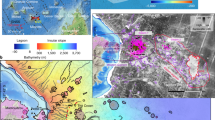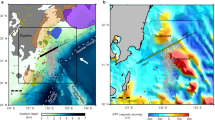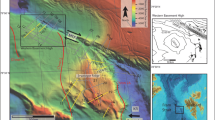Abstract
Black-smoker hydrothermal systems at mid-ocean ridges are often driven by heat loss from a crustal magma chamber1,2,3, but black-smoker systems have not been detected above all magma chambers4,5. The high fluxes of heat recorded at black-smoker systems require a thin, metre-scale conductive boundary layer at the top of the magma chamber, separating hydrothermal fluids from magma2,6. Extensive seismicity above the magma chambers7,8,9,10,11 has been attributed to stresses from hydrothermal cooling8,9,10,12. The presence of high-temperature hydrothermal systems has previously been linked with episodes of magma chamber inflation2,6,13,14, but the exact mechanism remained to be clarified. Here we analyse seismic data for the Endeavour segment of the Juan de Fuca ridge—a site of long-lived hydrothermal activity—recorded by seismometers located beneath the sea floor. Earthquake focal mechanisms derived from the data reveal a transition from normal faulting above the mid-crustal magma chamber to reverse faulting on either flank. This pattern of faulting is consistent with stress perturbations resulting from the emplacement of pressurized magma that forms a thin sill. We suggest that the ongoing recharge of magma into a crustal magma chamber not only replenishes the heat source2,6,14, but also helps maintain a thin conductive boundary layer that would otherwise thicken owing to water–rock interactions and crystallization at the chamber roof.
This is a preview of subscription content, access via your institution
Access options
Subscribe to this journal
Receive 12 print issues and online access
$259.00 per year
only $21.58 per issue
Buy this article
- Purchase on Springer Link
- Instant access to full article PDF
Prices may be subject to local taxes which are calculated during checkout




Similar content being viewed by others
References
Cann, J. R. & Strens, M. R. Black smokers fuelled by freezing magma. Nature 298, 147–149 (1982).
Lowell, R. P. & Germanovich, L. N. On the temporal evolution of high-temperature hydrothermal systems at ocean ridge crests. J. Geophys. Res. 99, 565–575 (1994).
Van Ark, E. M. et al. Seismic structure of the Endeavour Segment, Juan de Fuca Ridge: Correlations with seismicity and hydrothermal activity. J. Geophys. Res. 112, B02401 (2007).
Haymon, R. M. et al. Hydrothermal vent distribution along the East Pacific Rise crest (9∘09′–54′ N) and its relationship to magmatic and tectonic processes on fast-spreading mid-ocean ridges. Earth Planet. Sci. Lett. 102, 513–534 (1991).
Hooft, E. E. E., Detrick, R. S. & Kent, G. M. Seismic structure and indicators of magma budget along the Southern East Pacific Rise. J. Geophys. Res. 102, 27319–27340 (1997).
Liu, L. & Lowell, R. P. Models of hydrothermal heat output from a convecting, crystallizing, replenished magma chamber beneath an oceanic spreading centre. J. Geophys. Res. 114, B02102 (2009).
McClain, J. S. et al. Seismicity and tremor in a submarine hydrothermal field: The northern Juan de Fuca Ridge. Geophys. Res. Lett. 20, 1883–1886 (1993).
Wilcock, W. S. D., Archer, S. D. & Purdy, G. M. Microearthquakes on the Endeavour segment of the Juan de Fuca Ridge. J. Geophys. Res. 107, 2336 (2002).
Sohn, R. A., Hildebrand, J. A. & Webb, S. C. A microearthquake survey of the high-temperature vent fields on the volcanically active East Pacific Rise. J. Geophys. Res. 104, 25,367–25,377 (1999).
Sohn, R. A., Barclay, A. H. & Webb, S. C. Microearthquakes patterns following the 1998 eruption of Axial Volcano, Juan de Fuca Ridge: Mechanical relaxation and thermal strain. J. Geophys. Res. 109, B01101 (2004).
Tolstoy, M. et al. Seismic identification of along-axis hydrothermal flow on the East Pacific Rise. Nature 451, 181–185 (2008).
Lister, C. R. B. in Hydrothermal Processes at Seafloor Spreading Centers (eds Rona, P. A., Bostrom, K., Laubier, L. & Smith, K. L. Jr) 141–168 (Plenum, 1983).
Singh, S. C. et al. Seismic evidence for a hydrothermal layer above the solid roof of the axial magma chamber at the southern East Pacific Rise. Geology 27, 219–222 (1999).
Humphris, S. E. & Cann, J. R. Constraints on the energy and chemical balances of the modern TAG and ancient Cyprus seafloor sulfide deposits. J. Geophys. Res. 105, 28477–28488 (2000).
Kelley, D. S., Baross, J. A. & Delaney, J. R. Volcanoes, fluids, and life at mid-ocean ridge spreading centers. Annu. Rev. Earth Planet. Sci. 30, 385–491 (2002).
Johnson, H. P. et al. Earthquake-induced changes in a hydrothermal system on the Juan de Fuca Ridge mid-ocean ridge. Nature 407, 174–177 (2000).
Lilley, M. D., Butterfield, D. A., Lupton, J. E. & Olson, E. J. Magmatic events can produce rapid changes in hydrothermal vent chemistry. Nature 422, 878–881 (2003).
Seyfried, W. E. Jr, Seewald, J. S., Berndt, M. E., Ding, K. & Foustoukos, D. I. Chemistry of hydrothermal vent fluids from the Main Endeavour Field, northern Juan de Fuca Ridge: Geochemical controls in the aftermath of the June 1999 seismic events. J. Geophys. Res. 108, 2429 (2003).
Butterfield, D. A. et al. Gradients in the composition of hydrothermal fluids from the Endeavour segment vent field: Phase separation and brine loss. J. Geophys. Res. 99, 9561–9583 (1994).
Waldhauser, F. HypoDD—a program to compute double-difference hypocenter locations US Geol. Surv. Open File Rep. 01-113 (2001).
Thompson, W. J. et al. Heat flux from the Endeavour segment of the Juan de Fuca Ridge. Eos 86, Fall Meet. Suppl. abstr. T31A-0489 (2005).
Hardebeck, J. L. & Shearer, P. M. A new method for determining first-motion focal mechanisms. Bull. Seismol. Soc. Am. 92, 2264–2276 (2002).
Rubin, A. M. Dike-induced faulting and graben subsidence in volcanic rift zones. J. Geophys. Res. 97, 1839–1858 (1992).
Kent, G. M., Harding, A. J. & Orcutt, J. A. Evidence for a smaller magma chamber beneath the East Pacific Rise at 9∘30′ N. Nature 344, 650–653 (1990).
Pollard, D. D. & Segall, P. in Fracture Mechanics of Rock (ed. Atkinson, B. K.) 277–349 (Academic, 1987).
Buck, W. R., Einarsson, P. & Brandsdottir, B. Tectonic stress and magma chamber size as controls on dike propagation: Constraints from the 1975–1984 Krafla rifting episode. J. Geophys. Res. 111, B12404 (2006).
Chadwick, W. W. Jr. et al. Vertical deformation monitoring at axial seamount since its 1998 eruption using deep-sea pressure sensors. J. Volcanol. Geotherm. Res. 150, 313–327 (2006).
Tolstoy, M. et al. A sea-floor spreading event captured by seismometers. Science 314, 1920–1922 (2006).
Wilcock, W. S. D. & Delaney, J. R. Mid-ocean ridge sulfide deposits: Evidence for heat extraction from magma chambers or cracking fronts? Earth Planet. Sci. Lett. 145, 49–64 (1996).
Lister, C. R. B. Differential thermal stress in the Earth. Geophys. J. R. Astron. Soc. 86, 319–330 (1986).
Klein, F. W. User’s guide to HYPOINVERSE-2000, a Fortran program to solve for earthquake locations and magnitudes US Geol. Surv. Open File Rep. 02-171 (2002).
Acknowledgements
We thank J. Delaney and D. Kelley for their leadership of the programme that included this experiment; D. Bowman, J. Parker, H. Patel, C. Schmidt and student participants in a Friday Harbor Laboratories research apprenticeship for assistance with the initial data analysis and R. Lowell and R. Reves-Sohn for reviews that improved the manuscript. The W. M. Keck Foundation supported this research.
Author information
Authors and Affiliations
Contributions
P.R.M., D.S.S. and T.M.R. developed and prepared the seismometers. All the authors participated in the experiment at sea. W.S.D.W., E.E.E.H., D.R.T. and A.H.B. oversaw the initial data analysis. W.S.D.W. completed the analysis and wrote the paper, with editing from the other authors.
Corresponding author
Supplementary information
Supplementary Methods
Supplementary Information (PDF 704 kb)
Rights and permissions
About this article
Cite this article
Wilcock, W., Hooft, E., Toomey, D. et al. The role of magma injection in localizing black-smoker activity. Nature Geosci 2, 509–513 (2009). https://doi.org/10.1038/ngeo550
Received:
Accepted:
Published:
Issue Date:
DOI: https://doi.org/10.1038/ngeo550
This article is cited by
-
Multi-scale Quantitative Risk Analysis of Seabed Minerals: Principles and Application to Seafloor Massive Sulfide Prospects
Natural Resources Research (2019)
-
Geochemistry of mafic rocks and melt inclusions and their implications for the heat source of the 14.0°S hydrothermal field, South Mid-Atlantic Ridge
Chinese Journal of Geochemistry (2014)
-
Where there's smoke there's fire
Nature Geoscience (2009)



